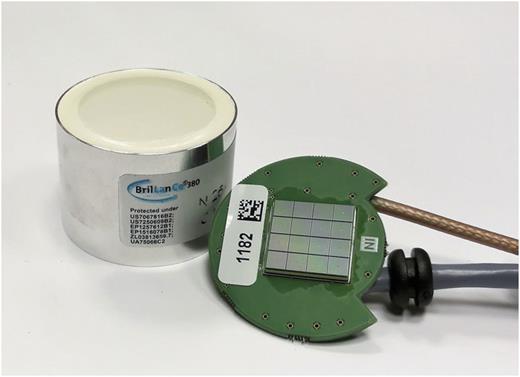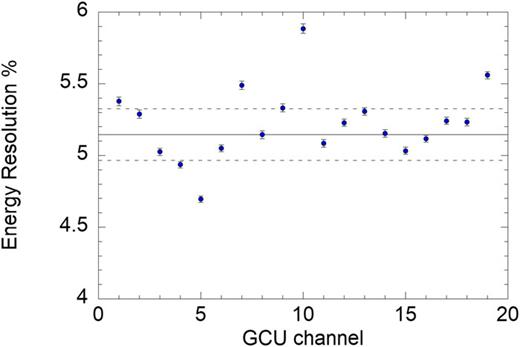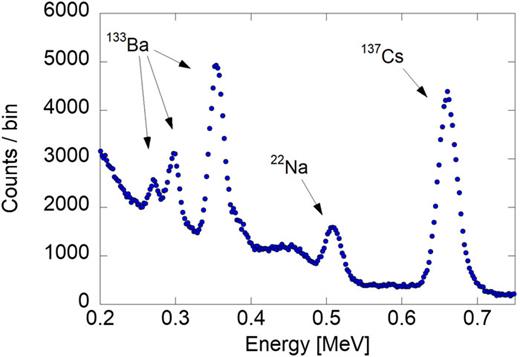The JET gamma-ray cameras have been recently upgraded within the gamma-ray camera upgrade project in support of development of JET high performance deuterium plasma scenarios and in preparation of deuterium-tritium experiments. New, dedicated detectors based on a LaBr3 crystal and silicon photo-multipliers have been developed and replaced pre-existing CsI detectors in all 19 channels. The new instrument gives opportunity of making two-dimensional gamma-ray measurements with a counting rate capability exceeding 1 MCounts/s (MCps) and energy resolution better than 5% at 1.1 MeV. The upgrade is of relevance for fast ion and runaway electron physics studies in high performance deuterium discharges and also in plasmas with tritium at neutron yields in the range up to about 5 × 1017 n/s.
I. INTRODUCTION
The role of gamma-ray spectroscopy as fusion plasma diagnostics technique has evolved significantly over the time. Historically, gamma-ray spectroscopy was proposed to assess the fusion reaction rate as a complementary technique to neutron flux measurements or as unique technique in case of aneutronic fusion reactions.1,2 More recently, as demonstrated at JET,1–9 gamma-ray spectroscopy has been proposed and used for studying the behavior of fusion reaction products as well as of other energetic ions. In particular, the JET gamma-ray cameras (GCs) play an important role providing measurements of the spatial distribution of the emitted gamma-rays which are mainly due to reactions between fast particles (p, d, t, α, and 3He) and fuel ions or impurities (9Be and 12C). At JET, as well as at ITER,10,11 the presence of beryllium impurities due to the Be first wall offers the opportunity for studying the fusion alpha particles in deuterium-tritium (DT) plasmas through the 9Be(α,nγ)12C reaction which emits 4.44 MeV γ-rays from the de-excitation of the 12C first level. Experimentally, measurements in plasmas with tritium are particularly challenging due to the harsh environment given by the intense fluxes of 14 MeV neutrons that interact either with the detector itself12,13 or with the surrounding tokamak structures, resulting in high background contribution. For this reason, at JET, several diagnostics are undergoing upgrades and improvements in order to cope with the high neutron/gamma fluxes expected in the next high-power D and DT campaigns and to enable gamma-ray spectroscopy at MCps counting rates.14–16 Among these diagnostics, the GC has been very recently upgraded within the EUROfusion enhancement program, achieving improvements both in terms of energy resolution and counting rate capability. The GC is made by a horizontal and vertical fan shaped camera viewing the plasma along 10 and 9 lines of sight, respectively. Previously, CsI scintillators coupled to pin-diodes were employed for gamma-ray detection, but they had almost no spectral capabilities and a slow decay time (0.5–4 μs), preventing the use of the system at high heating power of interest for fusion performance. The target of the upgrade consists of replacing the existing detectors with high performance spectrometers that combine high energy resolution (<5% at 1.1 MeV) and counting rate capabilities in excess of 500 kCps. Important space limitations, together with the needs of insensitivity to magnetic fields and the constraint of no modification of the frame, supports, and shielding of the GC, led us to develop custom-made detectors which were not commercially available so far.
The developed solution is based on a LaBr3 scintillator crystal coupled to a Hamamatsu Silicon PhotoMultiplier (SiPM) which is embedded in a readout electronic board implementing a Capacitor-Resistor (CR) differentiator circuit used for signal shortening. The full system is equipped with real-time temperature monitors and integrated power supplies which provide stabilized bias voltage and gain compensation for each SiPM. The data acquisition (DAQ) system is based on eight analog to digital converters (4 channels each, 13 bits, 250 Msamples/s), and it implements real time algorithms on Field Programmable Gate Array (FPGA) which provides processed data for each detector.
In this work, the new system is presented together with in situ characterization measurements collected with standard gamma-ray sources after the detector installation in the JET Torus Hall. The detectors performance is described in terms of energy resolution, high counting rate capability and neutron resilience. A discussion on the expected performance of the upgraded gamma cameras (GCU) is also given based on measurements recorded at JET and at other nuclear facilities.
II. THE UPGRADED JET GAMMA-RAY CAMERAS
The severe requirements on the energy resolution and counting rate capabilities needed for the upgrade of the JET gamma cameras, together with the geometry constraints, led us to develop a new compact gamma-ray spectrometer based on a 25.4 mm × 16.9 mm (diameter × height) LaBr3 scintillator crystal coupled to a 12 × 12 mm2 SiPM (model S13361-3050NE-04) (see Fig. 1). Due to space limitations, the whole detector fits a cylindrical light-proof capsule of dimensions 35 × 35 mm2 which is the maximum dimension allowed by the GC interfaces. SiPMs have been chosen as alternative to conventional photomultiplier tubes because of their very compact size, high internal gain, and insensibility to the magnetic field. On the other hand, the SiPMs show a strong gain-temperature dependence18,25 and gain-voltage sensitivity,25 as well as a limited linearity, which has to be monitored and corrected during the operation or off-line. In our design, the SiPM is placed on a Printed Circuit Board (PCB) provided with a temperature sensor and the read-out electronic circuit. Here a CR differentiator circuit is implemented to shorten the output signal length enabling high rate capabilities. A signal with a Full Width Half Maximum (FWHM) of 41 ns (see Fig. 2) is achieved in order to reduce the probability of pile-up events with respect to the original signal length (about 300 ns FWHM). On the other hand, the CR circuit introduces a reduction in pulse amplitude, which is however acceptable for this application. The electronic circuit was built ad hoc to match the existing JET cable impedance of 75 Ω. The output signal of each detector is fed to a digital data acquisition system based on the Advanced Telecommunications Computing Architecture (ATCA) able to digitize and simultaneously process the signals at 200 MSamples/s and 13 bits.17 Dedicated algorithms implemented on FPGAs have been developed for real time processing and data reduction to cope with the expected high counting rates.17 The DAQ system offers the possibility to be operated in different modes depending on the needs and on the expected fluxes. The system allows storing in continuous mode each sample or individual events or to save the relevant information of each event, such as the energy value and the trigger time, with a significant reduction in the data storage requirements. For this purpose, three selectable real-time algorithms have been implemented on FPGA and are based on pulse height analysis, digital trapezoidal shaper, and charge integration, whose details are described in Ref. 17. A device for real-time temperature monitoring and SiPM stabilization18 has been designed and implemented in the GCU. It allows communicating with each detector through a user-friendly interface allowing to set the optimized bias voltage value. Each temperature sensor is continuously read at fixed frequency (10 Hz), and the values are accessible through dedicated registers.
Picture of the LaBr3 scintillator crystal, the SiPM, and its read-out circuit board.
Picture of the LaBr3 scintillator crystal, the SiPM, and its read-out circuit board.
Example of waveform obtained after the detectors installation at JET and recorded with 80 m long cable.
Example of waveform obtained after the detectors installation at JET and recorded with 80 m long cable.
The new compact gamma-ray detectors and auxiliary systems have been successfully installed in both horizontal and vertical JET gamma-ray cameras in 2017. The new system was tested with 80 m long cables connecting the GCU detectors from the Torus Hall to the Diagnostic Hall where the GCU DAQ is located, and it is ready to provide data in the next D and DT JET campaigns.
III. RESULTS AND DISCUSSIONS
The detectors designed for the upgrade of the JET gamma-ray cameras have been fully characterized through in situ gamma-ray calibrations and previously at nuclear facilities and laboratory in terms of energy resolution and high counting rate capabilities.13,19,22 After the installation at JET, the 19 detectors have been tested with 137Cs, 133Ba, and 22Na radioactive sources which are embedded in the GCU shielding for calibration and reference (Fig. 3). At the optimum voltage of the SiPMs, the 19 detectors exhibit a mean energy resolution of about 5.2% at 662 keV of 137Cs (Fig. 4) which improves as a function of the energy19,20 as . The magnification of the recorded spectra at low energy from 0.2 MeV to 0.75 MeV (see an example in Fig. 5) highlights the enhanced spectroscopic capability of the upgraded gamma ray cameras. For the first time, the gamma cameras were able to resolve the three γ-ray lines emitted from 133Ba calibration source, which was not visible with the previous detectors. The spectrum also features the well-defined full energy peak of 137Cs and the full energy peak of 22Na at 0.511 MeV which arises on the Compton edge of the cesium line.
Pulse height spectrum recorded by the GCU detector in channel 5 during a 12 h calibration measurement.
Pulse height spectrum recorded by the GCU detector in channel 5 during a 12 h calibration measurement.
Energy resolution of the 19 detectors evaluated at the 137Cs full energy peak after their installation in the JET Torus Hall.
Energy resolution of the 19 detectors evaluated at the 137Cs full energy peak after their installation in the JET Torus Hall.
These results can be used to extrapolate favorably the study of fast ions at JET through γ-ray spectroscopy. In particular, an energy resolution better than 3% can be estimated at 4.44 MeV γ-rays emitted from 9Be(α,nγ)12C reactions. This results in GCU spatially resolved measurements for tracking the fast ions and for studying instabilities effects driven by fast ions.
The peaks at energies above 1.3 MeV in Fig. 3 are produced by the decay of the unstable radioisotopes of 138La and 227Ac which are present in the crystal. Due to their low intensities, they do not represent a strong interfering background in the measurements. On the contrary, the 138La peak at 1.436 MeV can be used to monitor the stability of each individual GCU detector in between JET discharges.19
The upgrade of the JET gamma-ray cameras is also motivated by the need of sustaining high counting rates.21 Monte Carlo simulations, in fact, revealed that the background gamma-ray fluxes21 will induce MCps counting rates in the detectors for both D and DT plasmas. This is mainly due to neutron-induced γ-ray background when neutrons interact with the existing shielding. More details on the neutron-induced gamma-ray fluxes at the detector positions for typical D and DT plasma operations are shown and discussed in Ref. 21. As presented by Rigamonti et al.19 and Nocente et al.,22 the behavior of the detector at a high counting rate has been investigated by irradiating the detector with Light Emitting Diode (LED) pulses and/or gamma-rays in the laboratory and at the TANDEM-ALPI nuclear accelerator in Legnaro (Italy). Measurements highlighted a gain shift of the SiPM sensor related to the increases of the current flowing in the SiPM itself when operating at high counting rates. As a consequence, a voltage drop across the SiPM occurs, which reduces the effective operating voltage of the device. This results in a reduction in the SiPM gain and, consequently, in a down shift of the peak position in the spectra which can be corrected offline thanks to time resolved measurements. A drift in the peak positions of about 5% at 1 MCps has been observed when a gamma-ray distribution with equivalent energy corresponding to the one predicted for the gamma background at JET, impinges on the detector.25 This limit is deemed acceptable for the GCU performance. The increasing average current flowing in the SiPM is proportional to the counting rate and to the equivalent energy deposited in the crystal. Finally, the gain shift is also related to the operating bias voltage of the SiPM, which determines the number of fired pixels of the SiPM and, therefore, the current. By operating the detector with dedicated settings, we have managed to show that operations up to 8 MCps are feasible in a high counting rate mock up experiment with LEDs. However, the data interpretation is particularly challenging in this case due to the severe pile up contribution. For this reason, we expect to be able to operate the GC up to neutron yields in the range of about 5 × 1017 n/s at JET,13 i.e., above the maximum performance expected in high power deuterium and trace tritium experiments, but below the record deuterium-tritium performance, which is projected to achieve neutron yields up to 1019 n/s. Neutron induced damage on the selected SiPM for the upgrade of the gamma cameras has been recently studied by Rigamonti et al.13 with 14 MeV neutrons, mostly showing an increase in the dark current of the device as a function of the neutron fluence. During the irradiation, the SiPM has experienced a neutron fluence of 4 × 1010 n/cm2 that, based on Monte Carlo simulations of the neutron fluxes at JET,21 corresponds to about 400 s and 4000 s integration time of a full power DT discharge (JET record discharge in 1997), in steady state conditions, for the horizontal and the vertical GCs, respectively. Since the expected duration of the heating phase in a typical JET discharge is about few seconds, we can conclude that neutron induced damage on the SiPM is in general of no concern for both the forthcoming planned DT and D plasma operations. More details on the neutron resilience of the SiPM and on the expected neutron fluxes at the detector positions for typical D and DT plasma operations are shown and discussed in Refs. 13 and 21, respectively.
The upgraded JET gamma-ray cameras now combine tomography with spectroscopy information. The enhancements in the energy resolution and in the counting rate capabilities bring favorable expectations for the study of the fast ions in the MeV energy range. A final point to note is also the capability of the GCU to contribute to runaway electron (RE) studies. In this case, it is the RE bremsstrahlung emission spectrum in the MeV range that needs to be measured to assess the RE energy distribution.23 From the diagnostics point of view, the detector must be able to sustain MCps counting rates, which are within the capabilities enabled by the present upgrade. A preliminary study has positively shown that SiPM based detectors can be applied for these measurements,24 even though some specific aspects, such as the energy non-linearity and the limited dynamic range to energies up to about 20 MeV must be corrected for.
IV. CONCLUSIONS
A dedicated compact gamma-ray spectrometer based on a LaBr3 scintillator crystal and a silicon photomultiplier (SiPM) has been developed to meet the target requirements for the upgrade of the JET gamma-ray cameras. The SiPM is integrated in a PCB that houses the read-out electronic circuit. Here a CR differentiator is implemented to shorten the output signal length enabling the MCps counting rate capabilities. The high light yields offered by the LaBr3 scintillator crystal, instead, allow spectroscopic measurements with enhanced energy resolution. The full system is also equipped with real-time temperature monitors and integrated power supplies which provide stabilized bias voltage and gain compensation for each SiPM. The data acquisition system is based on eight analog to digital converters (4 channels each, 13 bits, 250 Msamples/s) which implement real time algorithms on FPGAs providing processed data for each detector.
The new system has been successfully installed and tested on both the horizontal and vertical JET gamma-ray cameras during 2017. In general, the upgraded JET cameras now make gamma-ray measurements possible in deuterium plasmas at the highest neutron yields expected and in plasmas with tritium up to a yield of 5 × 1017 n/s. The instrument is of relevance for fast ion physics studies in conditions approaching the maximum JET plasma performance capabilities, which are among the core missions of this machine toward a new fusion energy breakthrough in deuterium-tritium.
ACKNOWLEDGMENTS
This work has been carried out within the framework of the EUROfusion Consortium and has received funding from the Euratom research and training programme 2014-2018 under Grant Agreement No. 633053. The views and opinions expressed herein do not necessarily reflect those of the European Commission.










